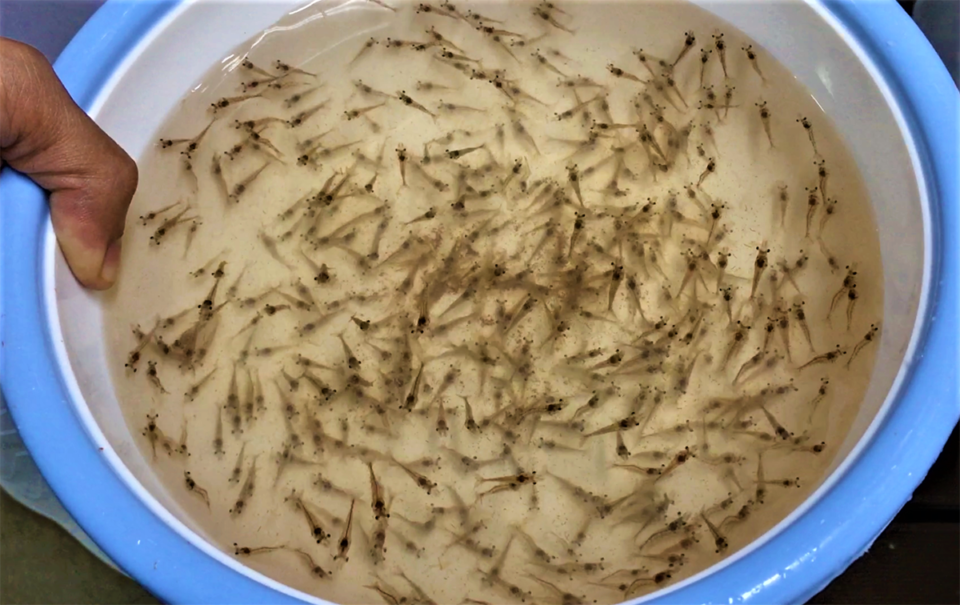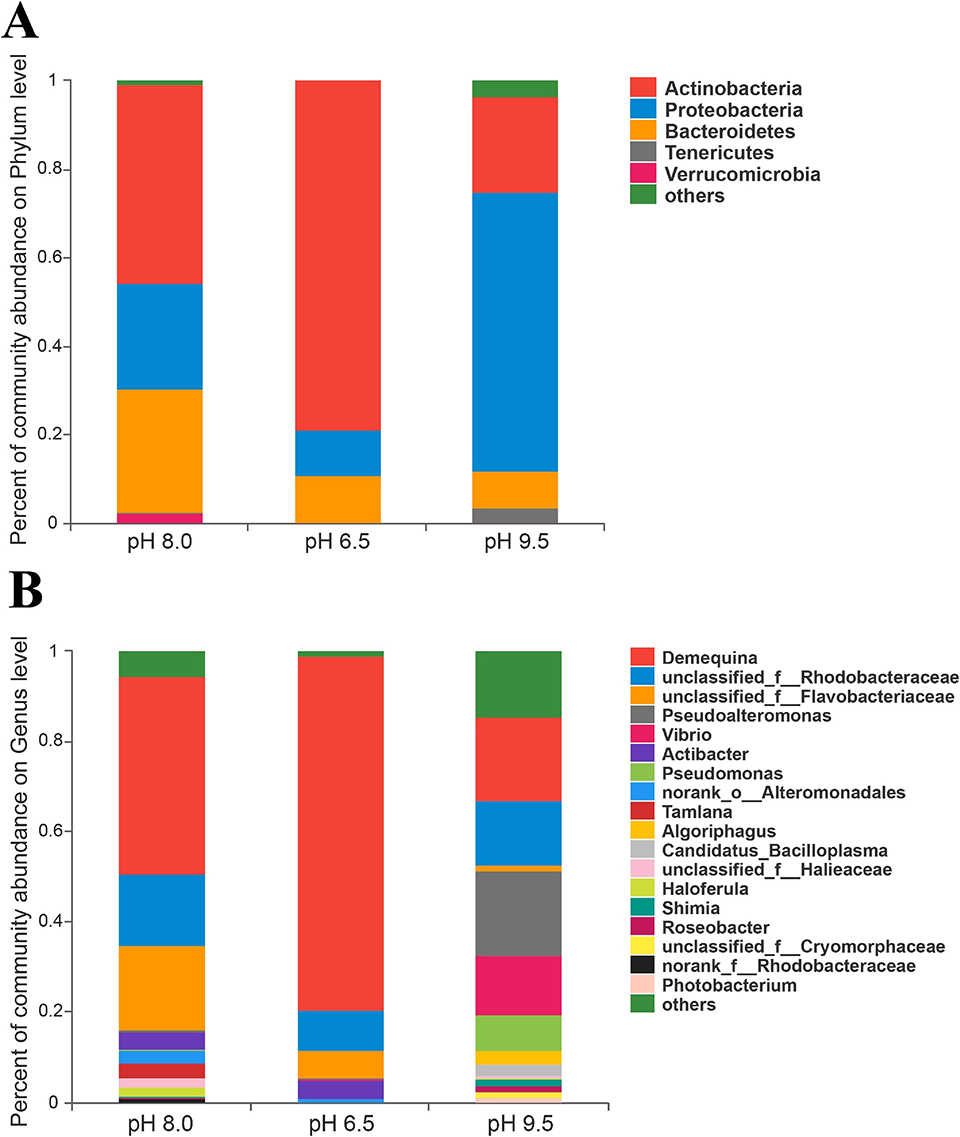Results suggest undesirable impacts on growth, immunity, gut microbiota functions

The pH value [a measure of the acidity of an aqueous solution] is one of the most sensitive environmental stress factors for aquacultured animals and can fluctuate between 6.6 and 10.2 because of photosynthesis and respiration activities in the water. As a euryhaline [an organism that can adapt to a wide range of salinities] species, the proper physiological functions of the Pacific white shrimp (Litopenaeus vannamei) are affected by pH stress, which can induce oxidative stress, reduce antioxidative ability and immune parameters, destroy intestine tissues and change intestine microbiota.
An aquatic animal’s response to pH stress is a complex process involving adjustments in its immune system, antioxidant system and intestinal health. The shrimp intestine is an important organ for digestion, absorption and immune defense, and its microbiota structure plays an important role and is closely related to the health of the host. Environmental stress can interfere with the proper function of intestine barriers, weaken immunity response and increase the probability of pathogen infection.
This article – adapted and summarized from the original publication (Qiuran Yu et al. 2020. Growth and health responses to a long-term pH stress in Pacific white shrimp, Litopenaeus vannamei. Aquaculture Reports Volume 16, March 2020, 100280) evaluated the potential adverse effect of pH stress on based on animal survival, growth and various other parameters.
This study was supported by grants from the Agriculture Ministry Key Laboratory of Healthy Freshwater Aquaculture, Key Laboratory of Fish Health and Nutrition of Zhejiang Province, Key Laboratory of Freshwater Aquaculture Genetic and Breeding of Zhejiang Province of the Zhejiang Institute of Freshwater Fisheries (ZJK201911), the Hainan Provincial Key Research and Development Program (ZDYF2019068), National Key R&D Program of China (2018YFD0900400), and the initial fund from Hainan University for R&D (KYQD(ZR)1736).
Study setup
Juvenile L. vannamei were obtained from a local farm in Hainan, China, and acclimated to the experimental environment – rearing seawater with pH 8.0 to 8.2, salinity 28 to 30‰ and temperature 28 ± 2 degrees-C – for two weeks. Animals were fed a commercial feed (41 percent crude protein, 4 percent crude lipid) at 6 percent of their body weight daily.
After acclimation, the juveniles (average weight 2.6 ± 0.4 grams) were randomly divided into three groups for different pH treatments: control group (pH 8.0), pH 6.5 group (pH 6.5) and pH 9.5 group (pH 9.5) and stocked in aquaria at 167 shrimp per square meter. The shrimp were fed following the same protocol as during their acclimation, and water pH in the aquaria was monitored three times daily during the 28-day experiment.
Animal survival was assessed daily, and we also collected samples for various laboratory analyses to determine and evaluate shrimp growth, hepatosomatic index, antioxidant capacity, immune-related gene expression, intestine histology, and intestine microbiota.
For detailed information on the experimental design and setup, animals used, pH exposure and sampling; biochemical and gene expression analyses; functional analysis of the microbiota, and other parameters evaluated; and statistical analyses, please refer to the original publication.
Results and discussion
Innate immunity in crustaceans is one of the most important functions to prevent pathogen invasions, and previous research has reported that an acute environmental stress could affect the immune capability of L. vannamei. Our results show that the expression of several innate immunity pathways in both the pH 6.5 and pH 9.5 groups were down-regulated [cell process decreasing the quantity of a cellular component, such as RNA or protein, in response to an external stimulus], and the Casp-3 gene [a protein coding gene] was significantly down-regulated in the pH 9.5 group.
Our data also indicated that pH 6.5 and 9.5 stress affected the capability of L. vannameijuveniles to eliminate the pathogen and pattern recognition process, and even higher pH levels inhibited the ability to eliminate damaged cells. Also, the antioxidant capacities of shrimp at pH 9.5 or pH 6.5 were significantly reduced relative to the shrimp under the control pH 8.0.
Results showed that the weight gain rate was significantly decreased in shrimp at pH 9.5 compared with the control shrimp at pH 8.0. The hepatopancreas and intestine play an important role in the digestion, absorption, and antioxidant functions in shrimp. Our data show that the weight gain rate (WGR) in the pH 9.5 group was significantly lower than the WGR in the other two groups, while the hepatosomatic index, HSI [measure of the relative weight of the liver] was significantly increased in the pH 9.5 group, indicating that a high pH stress can affect shrimp digestion and absorption, and limit nutrient input for growth and stress resistance.

The structure and diversity of intestinal microbiota is an important factor for shrimp health, and environmental stress can alter the balance of the intestine microbiota and increase the risk of pathogen infection. In our study, the intestine epithelium tissue was atrophied in the pH 6.5 group and was damaged in the pH 9.5 group. Histology analysis showed that shrimp gut epithelial cells at pH 6.5 separated from the basement membrane, while epithelial cell necrosis were found in shrimp at pH 9.5.
We observed that under a chronic pH stress, the balance of intestinal microbiota in L. vannamei was disrupted and the ability of the intestine to screen bacteria in the water was weakened, providing an opportunity for pathogenic bacteria to invade. This imbalance in intestinal microbiota could directly influence the immune system in shrimp, and the change in intestinal microbiota was closely related to the environment.

The intestine cannot perform its normal functions when the shrimp are under a pH stress, and the composition of the intestinal microbiota may show irregular patterns. The microbiota composition may be affected by both seawater and feed intake, and other studies have reported Proteobacteria as the most important microbiota in the intestine of L. vannamei, but in our study, both Actinobacteria and Proteobacteria were the main phyla observed.
At pH 6.5, the intestine barrier functions were weakened for protein and carbohydrate digestion and absorption. At pH 9.5, antibiotics biosynthesis pathways for several compounds were significantly decreased. This was associated with the decrease in the proportion of Actinobacteria in the pH 9.5 group and is likely to promote the growth of multiple bacteria in the shrimp intestine and disrupt the composition of intestine microbiota.
Perspectives
We assessed the effects to juvenile L. vannamei of exposure a higher pH 9.5 or a lower pH 6.5 than normal pH 8.0 for four weeks, and evaluated shrimp growth performance, antioxidant capacity, immune functions and intestinal histological damage and microbiota.
Our results suggest that the long-term exposure to lower or higher pH stress can adversely affect shrimp gut microbiota functions, thus leading to reduced growth, immunity and antioxidant capacity, and even intestine histological damage.
References available from the original publication.
Now that you've finished reading the article ...
… we hope you’ll consider supporting our mission to document the evolution of the global aquaculture industry and share our vast network of contributors’ expansive knowledge every week.
By becoming a Global Seafood Alliance member, you’re ensuring that all of the pre-competitive work we do through member benefits, resources and events can continue. Individual membership costs just $50 a year. GSA individual and corporate members receive complimentary access to a series of GOAL virtual events beginning in April. Join now.
Not a GSA member? Join us.
Author
-
Jia Xie, Ph.D.
Corresponding author
Key Laboratory of Tropical Hydrobiology and Biotechnology of Hainan Province
Hainan University, Haikou, Hainan, 570228, China
Editor's Note: This article has nine co-authors (all listed under “keywords”) but the contact information of only one of the corresponding co-authors, Dr. Jia Xie, is included.[110,99,46,99,97,46,99,105,121,64,101,105,120,106]
Tagged With
Related Posts

Health & Welfare
Effect of Streptomyces probiotics on gut microbiota of Pacific white shrimp
Study assessed shrimp juveniles fed enriched probiotic formulations, improving our understanding of the composition and dynamics of intestinal microbiota.

Health & Welfare
Feed additives based on quorum sensing disruption could aid fight against EMS
The pathogenicity of early mortality syndrome in shrimp is likely regulated by quorum sensing, which allows the Vibrio bacteria that colonize shrimp guts to coordinate the release of the toxin that damages shrimp digestive systems.

Health & Welfare
Aiding gut health with a natural growth promotor
A study with Nile tilapia conducted in commercial production cages in Brazil showed the potential – in the absence of major disease threats – of a commercial, natural growth promotor that modulates the microbiota (inhibiting growth of pathogenic bacteria and promoting growth of beneficial bacteria) and inhibits quorum sensing.

Health & Welfare
The intestinal microbiota in leopard coral grouper
Study investigates microbiota and host metabolism in the coral leopard grouper, an important fisheries species in Asian markets and only recently cultured.


